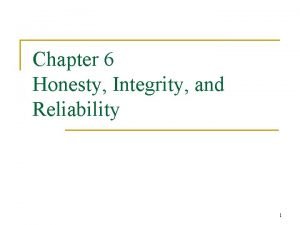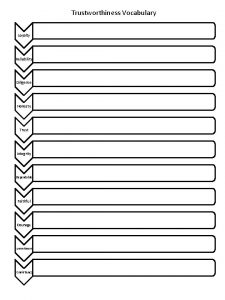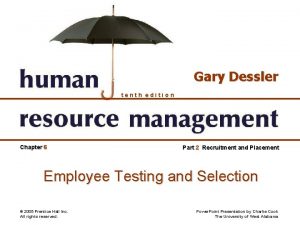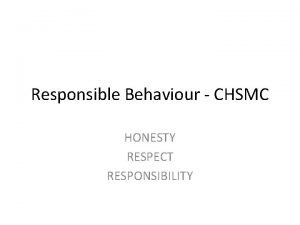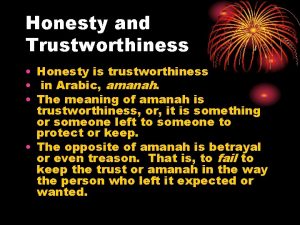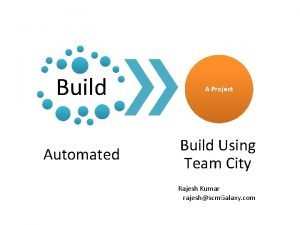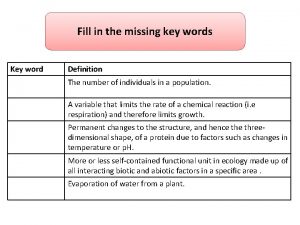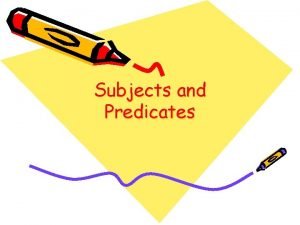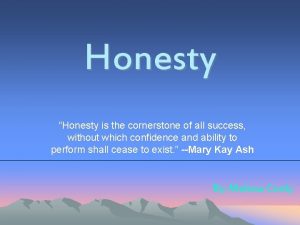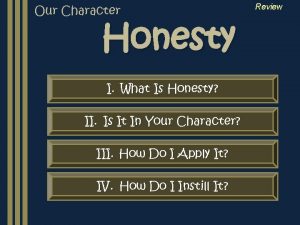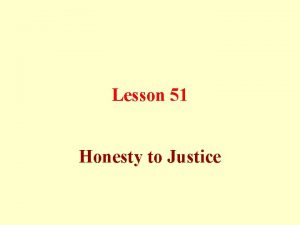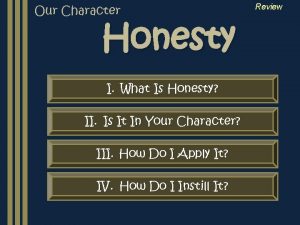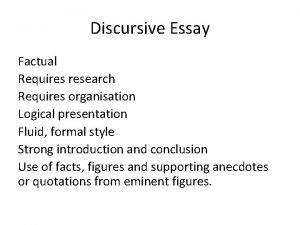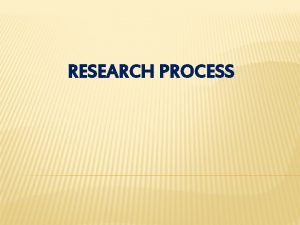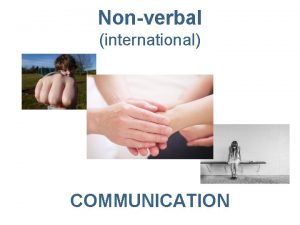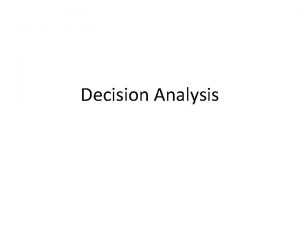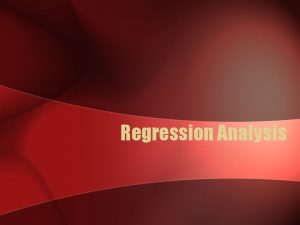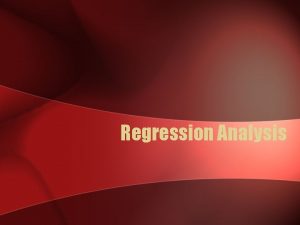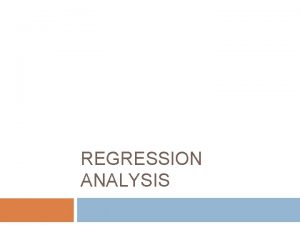Module 3 Analysis The process requires complete honesty



















































- Slides: 51

Module 3 Analysis

The process requires complete honesty and no predetermined assumptions.

Follow The Data!! Predetermined Assumption Don’t get caught in the Predetermined assumption trap!!!!

“Operator Error” Used too often. Used as easy way out. The problem lies with the process, not the operator!

Why do people not perform? Improper Instructions Improper Tools Improper Training Lost Expectations

Dont Limit The Search! What role did management systems play? Are you looking beyond your own back yard?

Why Why? ? (Cause and effect) Even the most serious or complex problems can be handled by using the why-why method coupled with cause chain diagrams.

Just Keep Asking “Why? ” Event: Didn’t get to work on time. EQ: Why were you late? Car wouldn’t start. Why didn’t it start? Battery was dead. Why was the battery dead? Dome light stayed on all night. Why was the light on? Kids played in car , left the door ajar

Take small steps! Work from an effect back to a cause Restate the cause as a problem(Why…. ? ) Find the next cause Repeat until you run into success

The Best Question is. . . one that starts with “WHY? ” If you want to get the most out of your Data: Make Questions Simple Don’t ask complex or poorly focused questions, they will lead you off the correct path and waste time.

So what does why-why do for you? It creates your cause chain which will contain 3 types of causes: Direct Cause Contributing Cause Root Cause Let’s look at definitions for these…. .

Direct Cause: The first cause(s) after the event.

Contributing Cause: The causes after the Direct Cause(s).

Root Cause: The last cause(s) in the chain. ( The fundamental reason for the event)

Let’s put labels on the chain! Event: Didn’t get to work on time. Why were you late? Direct Cause Car wouldn’t start. Why didn’t it start? Contributing Battery was dead. Why was the battery dead? Contributing Dome light stayed on all night. Why was the light on? Root Cause Kids played in car , left the door ajar

Picking Up the Pieces Event Direct Cause Contributing Cause Root Cause Contributing Cause

How many Root Causes can you have? Event Problem One Problem Two Direct Cause Root Cause

How many Root Causes can you have? (cont. ) Event Direct Cause Contributing Cause Root Cause

How many Root Causes can you have? Event (cont. ) Direct Cause Contributing Cause None if the trail is lost!!

How many Contributing Causes can you have? Event Direct Cause Root Cause Contributing Cause Many to none, depending on the size of the problem

Big Clue!! When a cause has two or more items inside of it, it may be time for a new branch!

How to keep things straight: Write down each possible cause. Use the why-why process to sort. Start with the event question. Take small steps. Solutions come later! Test the chain!

Let’s put labels on the chain! Event: Didn’t get to work on time. Why were you late? Direct Cause Car wouldn’t start. Why didn’t it start? Contributing Battery was dead. Why was the battery dead? Contributing Dome light stayed on all night. Why was the light on? Root Cause Kids played in car , left the door ajar

Find Direct, Contributing, and Root causes. Exercises 1 -9 PW Pages 12, 13, and 14 Use only what you’ve been given for causes! Remember: - Think about possible branching. - Problems may not have Contributing Causes, Direct could lead straight to Root Causes. - Contributing Causes may not have Root Causes

Event 1 Kid comes home with an “A” on a test Causes: ___ Kid Knew Material ___ New girlfriend would not go out on date unless kid passed test. ___ Kid studied real hard. Answers: Direct cause Kid knew material Contributing. Cause Kid studied real hard Root Cause New girlfriend would not go out on late date unless kid passed test

Cause and Effect Received ticket for safety violation. Car exhaust to loud. Muffler knocked loose from tailpipe. Daughter hit pothole. Potholes in road. Winters damage roads. Congress won’t allow money needed for repair. Congress doesn’t have extra money. Congress spent money on pork barrels. Too many lawyers in congress. Like answering questions from a four year old child, asking why can be taken to far.

Ignorance Y-Y Curve Unworkable Workable Times “Why” asked Silly

Did you go to far? Root Cause: Do we own it? If the root cause lies within our facility, inside the company, or even inside a vendor, we have ownership.

Instructions for Mill Fire Exercise Blue Sheets under tab 10 Using forms 2 a and 2 b: • Using the Data to build cause chains for the fire and the burns. • Use the why-why method and start with your event questions.

The Causes are your Keystones Direct Corrective Action Contributing Root

Bridge Between The Event and The Solution Event Solution Building a bridge between an event and a solution requires finding the correct causes. If you don’t know what caused the problem, how are you going to fix it?

Review How do you begin your analysis? Where does the event question lead you? What follows the direct cause? What’s the last cause in the chain called?

Module 4 Solutions

Corrective Action Definition Corrective Action: A set of planned actions implemented for the purpose of resolving the problem.

True or False If you correct only the root cause, every problem will be fixed forever.

Two Types of Corrective Action Specific Corrective Action ( changing the direct cause and effect) Preventive Corrective Action (eliminating contributing and root causes)

Specific Corrective Action: Actions taken to correct the direct cause and effect. *Event* Effect Specific C. A. Direct Cause Specific Corrective Action does not prevent recurrence! Occasionaly there is no specific corrective action! PW-3

Exercise Module 4 page 5 Using the four examples given on page 5 of your workbook, Identify the specific corrective actions to change the direct cause and to change the effect.

Preventive Corrective Action: Actions taken to prevent reccurrence of the event Contrib. Cause Root Cause Preventive C/A Preventive corrective actions focus on the root and contributing causes.

WHACK-A-MOLE Problems always popping up!!!

Corrective Action Effectiveness Defective Parts Change Material Not built to spec Material Type Small Quantities Increase Orders 95% Effective Add Processing 50% Effective Marginal Process 10% Effective PW-8

The more you run over a dead cat, Corrective Action the flatter it gets!!

Cost Of Non-Conformance Time Money Product Loss Customer Dissatisfaction Personal & Environmental Safety PW-9

Global Issues Definition: Significant issues with a high probability of occuring in areas outside of the teams control. What is a Global Issue to you? PW-10

Preventive Corrective Action Test “Common sense test” Do the preventive corrective actions lowers the risk of the event recurring to an acceptable level? Are the adverse effects caused by implementing the corrective actions that make them undesirable? For the interim actions the last question is changed to read: Do the interim corrective actions adequately lower the risk of the event recurring to an acceptable level until final preventive corrective actions can be completed. PW-11

Proper - W - Etiquette Why Is for Cause Chains What Who When Are for Corrective Actions PW-12

Corrective Action Implementation Prioritize actions by importance Schedule dates and milestones Track all commitments for timeliness Specify who is responsible

Exercise for problems on page 13…. Instructions Identify preventive corrective actions for the root and contributing causes. List the What, Who, When. Apply test from page 11

Warning Do What You Say! PW-14

…. Ensuring that corrective action is taken and effective If you say it. Do it! Be careful of your choice of words Dangerous: Words like “trained” and “all”

Mill Fire Exercise Determine the Corrective Actions Needed to Fix the Causes (What) Perform the Preventive Corrective Action Test Develop the Implementation Plan Who……What……When
 Difference between utilitarianism and virtue ethics
Difference between utilitarianism and virtue ethics Integrity appraisal comments examples
Integrity appraisal comments examples Question about honesty
Question about honesty Greek god of honesty
Greek god of honesty Valuing time in professional ethics
Valuing time in professional ethics Topic about honesty
Topic about honesty Quotes of elizabeth proctor
Quotes of elizabeth proctor Honesty integrity and reliability
Honesty integrity and reliability What is the difference between honesty and truth
What is the difference between honesty and truth Honesty personality
Honesty personality The honesty diploma
The honesty diploma Honesty vocabulary
Honesty vocabulary Honesty lasts longest
Honesty lasts longest Justice and honesty
Justice and honesty Honesty and dedication
Honesty and dedication Paper and pencil honesty test
Paper and pencil honesty test Honesty
Honesty Www.youtube.com
Www.youtube.com Honesty in arabic
Honesty in arabic Automated build process
Automated build process C device module module 1
C device module module 1 Complete the missing word to complete the three key words
Complete the missing word to complete the three key words Simple predicate examples
Simple predicate examples Hình ảnh bộ gõ cơ thể búng tay
Hình ảnh bộ gõ cơ thể búng tay Ng-html
Ng-html Bổ thể
Bổ thể Tỉ lệ cơ thể trẻ em
Tỉ lệ cơ thể trẻ em Chó sói
Chó sói Tư thế worm breton là gì
Tư thế worm breton là gì Hát lên người ơi alleluia
Hát lên người ơi alleluia Các môn thể thao bắt đầu bằng tiếng đua
Các môn thể thao bắt đầu bằng tiếng đua Thế nào là hệ số cao nhất
Thế nào là hệ số cao nhất Các châu lục và đại dương trên thế giới
Các châu lục và đại dương trên thế giới Công của trọng lực
Công của trọng lực Trời xanh đây là của chúng ta thể thơ
Trời xanh đây là của chúng ta thể thơ Cách giải mật thư tọa độ
Cách giải mật thư tọa độ Làm thế nào để 102-1=99
Làm thế nào để 102-1=99 độ dài liên kết
độ dài liên kết Các châu lục và đại dương trên thế giới
Các châu lục và đại dương trên thế giới Thể thơ truyền thống
Thể thơ truyền thống Quá trình desamine hóa có thể tạo ra
Quá trình desamine hóa có thể tạo ra Một số thể thơ truyền thống
Một số thể thơ truyền thống Cái miệng xinh xinh thế chỉ nói điều hay thôi
Cái miệng xinh xinh thế chỉ nói điều hay thôi Vẽ hình chiếu vuông góc của vật thể sau
Vẽ hình chiếu vuông góc của vật thể sau Biện pháp chống mỏi cơ
Biện pháp chống mỏi cơ đặc điểm cơ thể của người tối cổ
đặc điểm cơ thể của người tối cổ Thứ tự các dấu thăng giáng ở hóa biểu
Thứ tự các dấu thăng giáng ở hóa biểu Vẽ hình chiếu đứng bằng cạnh của vật thể
Vẽ hình chiếu đứng bằng cạnh của vật thể Fecboak
Fecboak Thẻ vin
Thẻ vin đại từ thay thế
đại từ thay thế điện thế nghỉ
điện thế nghỉ







